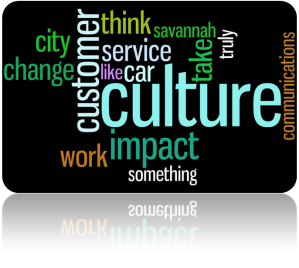 If there ever was a time for virtually every organization to assess their culture, this is it. Culture not only drives customer service, but it also drives long-term organizational success. While leaders can define the Desired Culture and can chart a Vision, leaders typically do very little of the actual work in any organization. Just think of the math. In an organization that has only 100 employees, the chief executive does about 1% of the work.
If there ever was a time for virtually every organization to assess their culture, this is it. Culture not only drives customer service, but it also drives long-term organizational success. While leaders can define the Desired Culture and can chart a Vision, leaders typically do very little of the actual work in any organization. Just think of the math. In an organization that has only 100 employees, the chief executive does about 1% of the work.
We are not diminishing the importance of the leader as much as we are highlighting the importance of the leader’s role in developing an engaged, productive, and effective workforce.
“This is an opportunity to rethink the future.”
Most organizations have been forced to transition because of changes in demand for services, changes in how services are delivered, or changes in where and how employees work. In other words, the external environment has forced internal change.
This is an opportunity to rethink the future. This is an opportunity for leaders to take a step back and paint a picture of the future business, the customer’s engagement with that business, and the type of internal culture needed to succeed in that new world.
Four Steps to Plan for Future Success
Here are four major steps to consider today to ensure your organization is still relevant and successful tomorrow:
- Create as clear a vision of the future customer as possible, including their needs and wants in both services and the service experience.
- Paint a vision of the services that are going to address the needs and wants of that future customer.
- Identify the mechanisms that you’re going to use, including processes, technology, and facilities, to deliver those services.
- Determine the kind of culture you need in order for that delivery approach to meet future customer needs.
The front-end key to this overall approach is to incorporate the Voice of the Customer to ensure you are creating this new Service System based on customer needs, issues, and goals. Don’t create a strategy in a vacuum.
The back-end key to this approach is to clearly work with staff to educate them on the future of the customer base and the future of the organization, and include them in the discussion of the desired culture and how to make that culture a reality.
This is a time to strengthen the culture, and to strengthen it you may need to pivot from where you’ve been in the past to where you need to be for future success.























